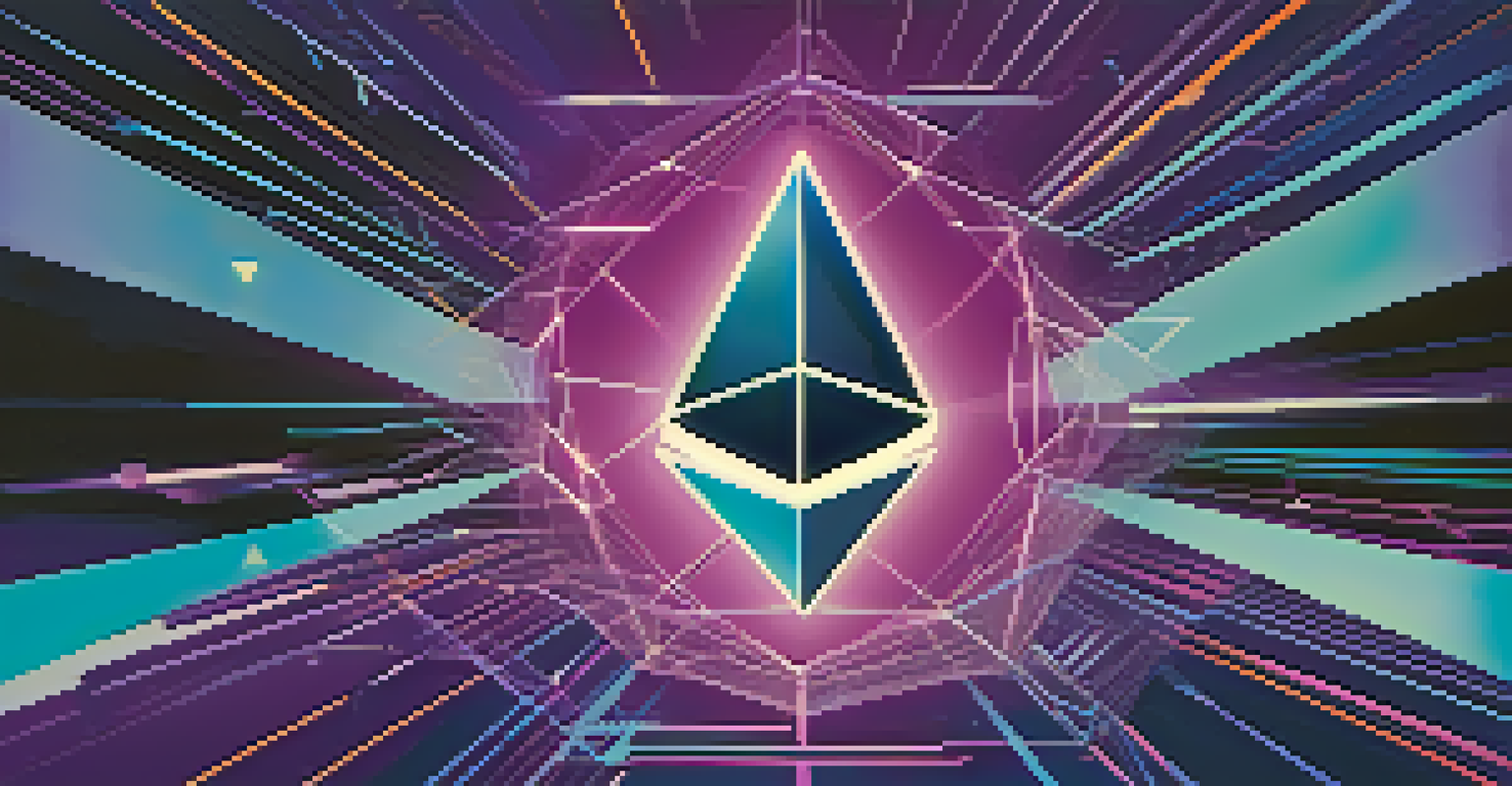Top Projects Enhancing Ethereum Interoperability Today

Understanding Ethereum's Interoperability Challenges
Ethereum, while incredibly popular, faces significant challenges when it comes to interoperability with other blockchain networks. This limitation can hinder the seamless flow of information and assets between platforms, which is crucial for a truly decentralized ecosystem. Without effective interoperability, Ethereum's potential for broader adoption and innovative applications remains constrained.
Ethereum is a platform for building decentralized applications, but interoperability is essential for unlocking its full potential.
The need for different blockchains to communicate is akin to ensuring that different languages can be understood by everyone. When projects can’t effectively talk to one another, it creates silos that stunt growth and innovation. As the crypto landscape evolves, addressing these challenges becomes increasingly important for developers and users alike.
Fortunately, several projects are emerging to tackle these interoperability issues head-on. By focusing on creating bridges and protocols that facilitate communication between Ethereum and other networks, these initiatives are paving the way for a more connected and efficient blockchain universe.
Polkadot: Bridging Multiple Blockchains
Polkadot stands out as one of the most ambitious interoperability projects in the blockchain space. By allowing multiple blockchains to operate in tandem, it creates a network where different chains can share information and functionality seamlessly. This multi-chain framework not only enhances scalability but also fosters innovation by enabling developers to create specialized blockchains tailored to specific use cases.

The concept of parachains is particularly interesting. These are individual blockchains that can connect to the Polkadot network, leveraging its security and interoperability features. This setup allows Ethereum projects to interact with various blockchains while maintaining their unique functionalities.
Interoperability Enhances Ethereum's Potential
Effective interoperability is crucial for Ethereum's broader adoption and innovative applications, allowing seamless communication between different blockchain networks.
As Polkadot continues to grow, it provides an exciting glimpse into the future of blockchain interoperability. Its success could inspire other networks to adopt similar strategies, ultimately leading to a more interconnected blockchain ecosystem.
Cosmos: The Internet of Blockchains
Cosmos aims to create an 'Internet of Blockchains' by enabling different blockchains to communicate with each other through its Inter-Blockchain Communication (IBC) protocol. This allows Ethereum and other blockchains to transfer tokens and data without the need for intermediary platforms. It’s like having a universal translator that makes conversations between different languages possible.
The future of blockchain is interconnected. To thrive, we must break down the silos between networks.
The modular design of Cosmos allows developers to build their own blockchains while still benefiting from the network's interoperability features. This flexibility empowers projects to innovate without being restricted by a single ecosystem, making it an attractive option for Ethereum developers.
As more projects adopt the Cosmos framework, the potential for cross-chain applications and collaborations grows exponentially. This interconnectedness not only enhances Ethereum's functionality but also enriches the entire blockchain landscape.
LayerZero: Omnichain Interoperability Protocol
LayerZero is an innovative protocol designed to facilitate omnichain interoperability, allowing different blockchains to communicate directly. This technology acts as a lightweight messaging layer, enabling Ethereum and other networks to share data without requiring complex bridge mechanisms. Think of it as a direct phone line between two friends, eliminating the need for third-party intermediaries.
By simplifying the communication process, LayerZero allows developers to create applications that can interact with multiple chains seamlessly. This can lead to enhanced user experiences and broader access to decentralized finance (DeFi) and non-fungible tokens (NFTs) across various platforms.
Innovative Protocols Drive Connectivity
Projects like Polkadot, Cosmos, and LayerZero are leading the way in creating solutions that enable different blockchains to communicate and share data effortlessly.
LayerZero's approach could redefine how developers think about building cross-chain applications. As it gains traction, we may see an influx of projects leveraging its capabilities, pushing Ethereum's interoperability to new heights.
The Graph: Decentralized Data Indexing
The Graph is not just about interoperability; it's about making data accessible across different blockchains, including Ethereum. As a decentralized indexing protocol, it helps developers query data from various networks quickly and efficiently. Imagine trying to find a specific book in a vast library—The Graph organizes that library, making it easier to locate what you need.
By allowing developers to build subgraphs, The Graph simplifies the process of accessing and managing data on Ethereum and beyond. This capability enhances the functionality of decentralized applications (dApps) and fosters a richer ecosystem.
As more projects utilize The Graph, the overall accessibility of blockchain data improves. This not only enhances Ethereum's interoperability but also empowers developers to create more sophisticated and user-friendly applications.
Wormhole: Cross-Chain Asset Transfers
Wormhole is a cross-chain messaging protocol that enables the transfer of assets between different blockchain networks, including Ethereum. This technology allows users to move tokens seamlessly across platforms, boosting liquidity and accessibility. Picture a bridge that connects two islands, making trade and communication much easier.
By facilitating these asset transfers, Wormhole enhances Ethereum's interoperability and allows users to access a broader range of decentralized applications and services. This capability is especially valuable in the rapidly evolving DeFi landscape, where users seek flexibility and options.
Future Projects Will Transform Ecosystem
As interoperability initiatives evolve, they promise to dissolve existing barriers, paving the way for exciting new use cases and collaborations in the blockchain space.
As Wormhole continues to expand its network of supported chains, the potential for cross-chain interactions grows. This could lead to a more integrated blockchain ecosystem, where users can fully leverage the strengths of multiple networks.
Chainlink: Decentralized Oracles for Interoperability
Chainlink serves as a decentralized oracle network that connects smart contracts with real-world data, bridging the gap between on-chain and off-chain environments. This capability is crucial for enhancing interoperability, as it allows Ethereum smart contracts to access data from various external sources. Think of Chainlink as a reliable messenger that delivers important information to smart contracts when they need it.
By providing secure and accurate data feeds, Chainlink empowers developers to create more complex and useful applications that can interact with multiple blockchains. This functionality not only broadens the scope of what Ethereum can accomplish but also enhances the overall ecosystem.

As the demand for reliable data continues to grow, Chainlink's role in facilitating interoperability becomes increasingly important. Its ongoing development and expansion will likely play a significant part in the future of Ethereum and its interoperability with other networks.
Future of Ethereum Interoperability Projects
The future of Ethereum interoperability looks promising, with several innovative projects leading the charge. As these initiatives evolve and mature, we can expect to see more fluid connections between Ethereum and other blockchains, boosting the overall functionality of decentralized applications. This interconnectedness could pave the way for exciting new use cases and collaborations that were previously unimaginable.
Moreover, as developers continue to explore and implement these interoperability solutions, the barriers that currently exist may begin to dissolve. This will open up opportunities for users to seamlessly transfer assets and information across various platforms, enhancing their experience in the blockchain ecosystem.
In summary, the advancements in Ethereum interoperability are crucial for the network's growth and adoption. By embracing these projects and their solutions, we can look forward to a more integrated and efficient blockchain landscape that benefits everyone involved.